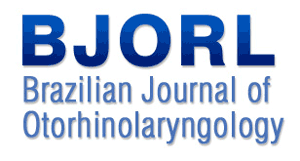Dear Editor,
We have followed with a great interest the article by Lavinsky et al. and herein we present a simple additional therapeutic strategy against SARS-COV-2.11 Lavinsky J, Kosugi EM, Baptistella E, Roithmann R, Dolci E, Ribeiro TK, et al. An update on COVID-19 for the otorhinolaryngologist — a Brazilian Association of Otolaryngology and Cervicofacial Surgery (ABORL-CCF) Position Statement. Braz J Otorhinolaryngol. 2020;86:273-80.
As recently demonstrated, climatic factors such as latitude, temperature, and humidity strongly influence the propagation of the COVID-19 virus.22 Auler AC, Cássaro FAM, da Silva VO, Pires LF. Evidence that high temperatures and intermediate relative humidity might favor the spread of COVID-19 in tropical climate: a case study for the most affected Brazilian cities. Sci Total Environ. 2020;729:139090. According to Sterling, some viruses prefer a high relative humidity, whereas some other viruses a low relative humidity, so there is an average humidity range between 50% and 70% in which the viral population is minimal.33 Sterling EM, Arundel A, Sterling TD. Criteria for human exposure to humidity in occupied buildings. ASHRAE Trans. 1985;91:611-22. However, current climatic transformations are determining strong thermal excursions, which could destabilize the climate and favor the survival of the virus. Although it is not realistically possible to change the global climate in the short term, changing indoor humidity and temperature in workplaces, schools, hospitals especially intensive care units could be a valid preventive and therapeutic strategy to reduce respiratory infections.33 Sterling EM, Arundel A, Sterling TD. Criteria for human exposure to humidity in occupied buildings. ASHRAE Trans. 1985;91:611-22.
The nose represents the first contact with inhaled pathogens and the target organ for SARS-CoV-2, due to the presence of virus receptors in the rhinopharynx. The anterior nasal segment and turbinates regulate temperature and humidity of inhaled air to near alveolar condition to protect the lungs. Although unlikely, drying of the mucous membranes of the nose and throat might increase susceptibility to respiratory infections.44 Zou L, Ruan F, Huang M, Liang L, Huang H, Hong Z, et al. SARS-CoV-2 Viral load in upper respiratory specimens of infected patients. N Engl J Med. 2020;382:1177-9. However, these phenomena might explain the higher vulnerability of elderly subjects to the viruses, who often complain of nasal dryness due to the degenerative effects of aging on nasal mucosa. Conversely, mucus might somehow, as in the pediatric population, prevent respiratory infections by preventing contaminated aerosols from reaching the lungs. These speculations do highlight the importance of preserving a good nasal physiology in the preparation of the inhaled air before reaching the lungs; cigarette smoking, intranasal vasoconstrictors or steroids, and previous turbinectomy operations, reducing nose moisture, could be predisposing factors to viral infection. An additional therapeutic strategy against SARS-COV-2 could be the creation, in both upper and lower airways, of conditions of temperature and humidity not favorable to the virus. In particular, humidification of the lungs might be useful in patients hospitalized for pneumonia, especially when oxygen therapy is needed.55 Schwartz JS, Tajudeen BA, Kennedy DW. Diseases of the nasal cavity. Handb Clin Neurol. 2019;164:285-302. For these reasons, the elderly, much more than young people, could benefit from a humidifying therapy of the intranasal air.
References
-
1Lavinsky J, Kosugi EM, Baptistella E, Roithmann R, Dolci E, Ribeiro TK, et al. An update on COVID-19 for the otorhinolaryngologist — a Brazilian Association of Otolaryngology and Cervicofacial Surgery (ABORL-CCF) Position Statement. Braz J Otorhinolaryngol. 2020;86:273-80.
-
2Auler AC, Cássaro FAM, da Silva VO, Pires LF. Evidence that high temperatures and intermediate relative humidity might favor the spread of COVID-19 in tropical climate: a case study for the most affected Brazilian cities. Sci Total Environ. 2020;729:139090.
-
3Sterling EM, Arundel A, Sterling TD. Criteria for human exposure to humidity in occupied buildings. ASHRAE Trans. 1985;91:611-22.
-
4Zou L, Ruan F, Huang M, Liang L, Huang H, Hong Z, et al. SARS-CoV-2 Viral load in upper respiratory specimens of infected patients. N Engl J Med. 2020;382:1177-9.
-
5Schwartz JS, Tajudeen BA, Kennedy DW. Diseases of the nasal cavity. Handb Clin Neurol. 2019;164:285-302.
Publication Dates
-
Publication in this collection
15 Mar 2021 -
Date of issue
Jan-Feb 2021

